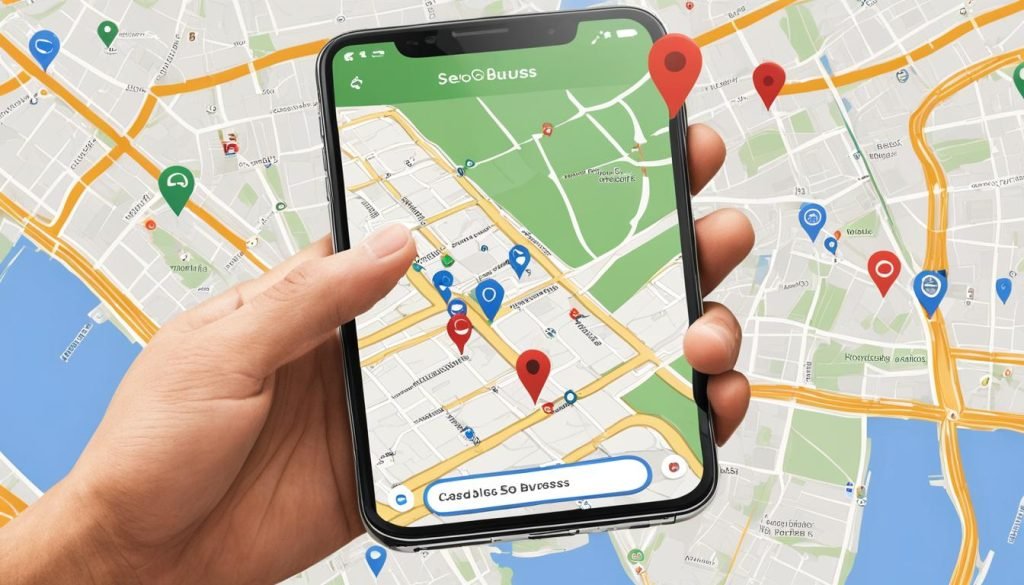Mobile SEO is crucial for businesses in today’s digital landscape. With the majority of web traffic coming from mobile devices and Google’s emphasis on mobile-first indexing, optimizing your website for mobile is essential. Mobile SEO involves practices such as mobile website optimization, mobile search engine optimization, and designing mobile-friendly websites. By implementing these strategies, businesses can enhance their online visibility, improve user experience, and drive organic traffic to their mobile site.
Key Takeaways:
- Mobile SEO is vital for businesses to improve their online visibility and reach their target audience on mobile devices.
- Optimizing your website for mobile includes mobile website optimization, mobile search engine optimization, and designing mobile-friendly websites.
- Mobile SEO can drive organic traffic, improve user experience, and lead to higher conversion rates.
- Working with a mobile SEO agency or expert can help businesses achieve maximum results and stay competitive.
- Implementing mobile SEO best practices, such as responsive design and optimizing site speed, is essential for success.
Why Mobile SEO Cannot Be Ignored
Mobile SEO is of utmost importance for your business’s online visibility and user experience. With the majority of internet searches originating from mobile devices, neglecting mobile SEO means missing out on valuable opportunities to reach your target audience. Furthermore, Google’s algorithms prioritize mobile-friendly websites, making it essential to optimize your mobile site design and functionality to maintain visibility in search results. By prioritizing mobile SEO, you can stay competitive, increase your online visibility, and provide a positive user experience for your mobile visitors.
Ensuring that your website is mobile-friendly is crucial for both search engine optimization and user satisfaction. With more people relying on their mobile devices for internet browsing, having a website that is optimized for mobile is essential. Google recognizes the importance of mobile-friendly websites and has implemented mobile-first indexing, which means that it primarily uses the mobile version of your website for ranking and indexing. If your website is not mobile-friendly, it may not rank well in mobile search results, resulting in a loss of online visibility.
Having a mobile-friendly website also contributes to a better user experience. Users expect websites to load quickly and provide a seamless browsing experience on their mobile devices. If your website is not optimized for mobile, it may load slowly, have layout issues, or offer a poor navigation experience. This can lead to high bounce rates, reduced user engagement, and ultimately, missed opportunities for conversions and revenue.
To ensure that your website is mobile-friendly, it is essential to implement responsive design principles. Responsive design allows your website to adapt to different screen sizes and resolutions, providing an optimal viewing experience across various devices. By using fluid grids, flexible images, and CSS media queries, you can create a website that looks and functions great on both desktop and mobile devices.
Benefits of Mobile-Friendly Websites:
- Improved visibility in mobile search results
- Enhanced user experience
- Reduced bounce rates
- Increased user engagement
- Higher conversion rates
By focusing on mobile SEO and ensuring that your website is mobile-friendly, you can optimize your online presence, reach a wider audience, and provide a positive user experience for mobile visitors. Don’t ignore the importance of mobile SEO in today’s digital landscape.
Benefits of Mobile SEO Services
Mobile SEO services offer several benefits for businesses. By optimizing your website for mobile devices, you can reach a wider audience and tap into the ever-growing mobile usage. With the majority of internet traffic coming from mobile devices, it’s essential to ensure that your website is mobile-friendly to maximize your audience reach.
One of the main benefits of mobile SEO is the potential for increased organic traffic. When your website is optimized for mobile, it becomes more visible in search engine results, leading to higher visibility and attracting more visitors to your website.
But it doesn’t stop at visibility. Mobile SEO also enhances user engagement. When users have a seamless experience on your mobile site, they are more likely to stay longer, explore your content, and interact with your brand. This increase in user engagement can have a positive impact on conversions, ultimately leading to higher revenue for your business.
Now, let’s take a closer look at the benefits of mobile SEO:
- Wider Audience Reach: By optimizing your website for mobile devices, you can tap into the growing mobile user base and reach a wider audience.
- Organic Traffic: Mobile SEO can drive organic traffic to your website by improving your visibility in search engine results.
- User Engagement: With a mobile-friendly website, you can enhance user engagement, leading to longer on-page time and increased interactions with your brand.
In order to fully unlock the benefits of mobile SEO, it’s recommended to seek the assistance of a mobile SEO agency or consultant. Their expertise and guidance can help you optimize your mobile presence and achieve the best possible results.
Investing in mobile SEO services not only ensures that your website is accessible and user-friendly on mobile devices, but it also opens up opportunities to connect with a wider audience, drive organic traffic, and enhance user engagement. By prioritizing mobile optimization, businesses can stay competitive in today’s digital landscape and reap the rewards of a well-optimized mobile presence.
Take a look at the table below for a detailed comparison of the benefits of mobile SEO services:
| Benefits of Mobile SEO Services | Description |
|---|---|
| Wider Audience Reach | Optimizing your website for mobile devices enables you to reach a wider audience, tapping into the growing mobile user base. |
| Organic Traffic | Mobile SEO improves your visibility in search engine results, driving organic traffic to your website. |
| User Engagement | A mobile-friendly website enhances user engagement, leading to longer on-page time and increased interactions with your brand. |

The Role of Mobile-Friendly Design in Mobile SEO
When it comes to mobile SEO, the role of mobile-friendly design cannot be underestimated. With the increasing use of mobile devices for browsing, it is essential to ensure that your website is optimized for mobile users. A mobile-friendly design refers to a website layout and structure that adapts seamlessly to different screen sizes and resolutions. By implementing responsive design principles, businesses can create a user experience that is consistent and engaging across various devices, including mobile phones and tablets.
A responsive design utilizes fluid grids, flexible images, and CSS media queries to automatically adjust the website’s layout based on the screen size. This means that regardless of whether a user accesses your website on a small smartphone screen or a larger tablet display, the content and functionality will be displayed in an optimized manner. This ensures that users can easily navigate your site, read the text, and interact with buttons and forms without any issues.
One of the key benefits of a mobile-friendly design is improved user experience. A website that is visually appealing and easy to navigate on mobile devices promotes longer engagement and encourages users to explore your content. By providing a seamless user experience, you can increase the likelihood of conversions and achieve your business goals.
Additionally, a mobile-friendly design contributes to the overall visual appeal of your website. It allows you to showcase your brand’s identity effectively, maintain consistency in your website’s aesthetics, and create a positive impression on mobile users. The visual appeal of your website plays a significant role in attracting and retaining users, making it a crucial aspect of mobile SEO.
To illustrate the importance of mobile-friendly design in mobile SEO, consider the following example:
According to a study conducted by Google, 61% of users are unlikely to return to a website they had trouble accessing on their mobile devices. This highlights the impact that a poorly designed mobile website can have on user experience and customer retention. By prioritizing mobile-friendly design, businesses can ensure that their website is accessible, visually appealing, and user-friendly across all devices.
When creating a mobile-friendly design, it’s essential to work with a mobile SEO expert or consultant who understands both design principles and SEO best practices. They can help you create a visually appealing website layout, optimize the website’s performance on mobile devices, and ensure that your mobile SEO efforts align with your overall digital marketing strategy.
Overall, a mobile-friendly design is an integral part of mobile SEO. It enhances user experience, improves website functionality on mobile devices, and contributes to the visual appeal of your brand. By implementing responsive design principles and working with experts in mobile SEO, businesses can optimize their mobile presence, attract more mobile users, and achieve their online goals.
The Impact of Mobile SEO on Local Search
Mobile SEO plays a crucial role in influencing local search results and capturing the attention of users conducting location-based searches. With the increasing prevalence of mobile searches, optimizing your website for local search is more important than ever.
When users perform mobile searches, they often have specific intent, searching for nearby businesses or services. By implementing local SEO optimization strategies, businesses can enhance their visibility in local search results and attract more customers in their target area.
One key aspect of effective mobile SEO is incorporating local keywords throughout your website’s content. By including location-specific terms in your title tags, meta descriptions, headings, and body text, you can signal to search engines that your website is relevant to the local search queries.
Optimizing your presence on Google My Business is also crucial for local search success. Ensure that your business’s information, including your name, address, and phone number (NAP data), is consistent and up to date across all online directories and platforms.
Did You Know?
Local search is even more prevalent when users are on the move. According to recent statistics, more than 50% of mobile searches have local intent, and approximately 78% of local mobile searches result in offline purchases.
To further boost your local search rankings, consider leveraging customer reviews and testimonials on your website. Positive reviews not only instill confidence in prospective customers but also act as social proof, demonstrating your credibility and trustworthiness.
Optimizing your website’s loading speed is another critical factor in mobile SEO for local search. Mobile users expect websites to load quickly, and a slow-loading site can deter users and negatively impact their experience. Implementing strategies such as image compression, file compression, and server optimization can significantly improve your site’s loading speed on mobile devices.
Now that you understand the impact of mobile SEO on local search, it’s time to implement relevant strategies and techniques to optimize your website for mobile users in your target area. Investing in local SEO optimization and ensuring that your website is mobile-friendly can help your business gain a competitive edge and attract more local customers.

Mobile SEO Best Practices
Implementing mobile SEO best practices is essential for achieving optimal results. By following these best practices, you can enhance your mobile website’s visibility, user experience, and overall performance.
1. Mobile-Friendly Design
Ensure that your website has a mobile-friendly design that is visually appealing and user-friendly. This includes using responsive design techniques, such as fluid grids and flexible images, to ensure that your website looks and functions well on any device. A mobile-friendly design improves user experience and encourages longer engagement.
2. Page Speed Optimization
Optimize your mobile website’s page speed to ensure quick loading times. Users expect fast-loading websites, and a slow-loading site can lead to higher bounce rates. Improve your page speed by compressing images, optimizing file sizes, and optimizing your server infrastructure for quick responses to user requests.
3. Engaging Headlines
Create compelling and engaging headlines that capture users’ attention. Your headline should be concise, relevant, and able to pique users’ curiosity. An engaging headline encourages users to click through and explore your content further, leading to increased user engagement.
4. High-Quality Content
Produce high-quality content that provides value and relevance to your mobile audience. Your content should be informative, well-written, and tailored to meet the needs and interests of your target audience. Delivering high-quality content establishes your credibility and encourages users to stay longer on your site.
5. Structured Data and Voice Search Optimization
Utilize structured data to provide search engines with additional context and information about your mobile website’s content. This helps search engines understand and index your content more effectively. Additionally, optimize your website for voice search by incorporating natural language and long-tail keywords that reflect how users ask questions verbally.
6. Clear Call-to-Action Buttons
Implement clear and compelling call-to-action buttons on your mobile website. These buttons guide users towards desired actions, such as making a purchase or filling out a form. Ensure that your call-to-action buttons are easy to find, visually appealing, and optimized for mobile devices to maximize user conversions.
By implementing these mobile SEO best practices, you can optimize your mobile website to achieve maximum visibility, user engagement, and conversions. Consider consulting with a mobile SEO expert or agency to receive guidance and assistance in implementing these best practices for your mobile site’s success.
Mobile SEO Strategies Based on the AIDA Model
When it comes to mobile SEO, aligning your strategies with the AIDA model can effectively guide users through the decision-making process on your mobile website. The AIDA model stands for Attention, Interest, Desire, and Action, representing the stages a user goes through before making a conversion. By understanding and implementing strategies for each stage, you can optimize your mobile website for maximum user engagement and conversions.
To capture users’ attention, focus on creating a visually appealing design that instantly grabs their attention. Use engaging headlines and compelling visuals that entice them to explore further.
“The first step in exceeding your customer’s expectations is to know those expectations.” – Roy H. Williams
Generating interest is crucial in prolonging user engagement. Providing high-quality and relevant content is key. Offer valuable information that resonates with your audience and keeps them interested in what you have to offer.
Creating desire entails demonstrating the mobile optimization of your website. Highlight the benefits and advantages of your mobile site, showcasing how it enhances the user experience. Social proof is also essential, whether through user reviews or testimonials, as it builds trust and strengthens the desire to take action.
Benefits of Mobile SEO Strategies Based on the AIDA Model:
- Increase brand awareness and visibility
- Enhance user engagement and dwell time
- Generate qualified leads and conversions
- Build customer loyalty and trust
Prompting action is the final stage of the AIDA model. Ensure that your mobile website has clear and compelling call-to-action buttons that guide users towards the desired action. Mobile-friendly forms are also crucial in facilitating an easy and seamless conversion process.
By following the AIDA model and incorporating these mobile SEO strategies, you can effectively guide users through the decision-making process on your mobile website. Ultimately, this can lead to increased user engagement, conversions, and the overall success of your mobile SEO efforts.
Importance of Site Speed in Mobile SEO
Site speed is a critical factor in mobile SEO. Mobile users expect fast-loading websites, and a slow-loading site can lead to higher bounce rates and lower user engagement. To improve site speed, you need to focus on several key areas of mobile optimization:
1. Image Compression
Optimize your images by compressing them without compromising quality. Using image compression tools can help reduce image file sizes, allowing for faster loading times on mobile devices. By implementing this technique, you can enhance user experience and boost mobile SEO performance.
2. File Compression
Consider using file compression techniques to reduce the size of CSS, HTML, and JavaScript files. Compressed files load faster, improving overall site speed. By minimizing file sizes, you can provide a seamless browsing experience for mobile users and positively impact your mobile SEO efforts.
3. Server Optimization
Optimizing your server infrastructure is crucial for quick responses to user requests. Ensure that your server can handle the increased demand from mobile users effectively. By optimizing your server, you can provide a smoother user experience and improve mobile SEO performance.
4. Mobile-First Principles
Designing your website with mobile-first principles in mind can significantly impact site speed. Prioritize mobile usability and ensure that your website is responsive and mobile-friendly. By adopting a mobile-first approach, you enhance user experience, increase engagement, and achieve better mobile SEO results.
By focusing on site speed optimization, including image compression, file compression, server optimization, and mobile-first principles, you can enjoy improved mobile SEO performance and provide a seamless browsing experience for your mobile audience.
The Role of Responsive Design in Mobile SEO
Responsive design plays a crucial role in mobile SEO by ensuring a seamless user experience across different devices. It involves using fluid grids, flexible images, and CSS media queries to create a website that adapts to various screen sizes, ultimately enhancing user experience and improving mobile SEO performance.
Firstly, responsive design utilizes fluid grids, which allow website layouts to adjust and resize proportionally based on the screen size. This flexible grid system ensures that the content and elements of a web page are displayed optimally, regardless of whether it is accessed on a desktop, tablet, or smartphone. By utilizing fluid grids, businesses can provide a consistent and visually appealing experience for their users, enhancing engagement and reducing bounce rates.
Additionally, responsive design ensures that images and media elements on a website are flexible and can scale down without losing quality. By using techniques like CSS max-width, images can be automatically resized to fit the screen width while maintaining their resolution and clarity. This fluidity in image display improves the overall aesthetics of the website and prevents large images from slowing down the page load speed, which is crucial for mobile SEO.
“Responsive design allows websites to adapt to different screen sizes for a seamless user experience.”
CSS media queries are another important component of responsive design. By applying CSS styles based on specific screen sizes, developers can create different layouts and designs tailored to different devices. This means that a website can have a different appearance and functionality on a mobile device compared to a desktop, ensuring that users have the best possible experience on each device. For example, a responsive design can display a simplified navigation menu on mobile screens to improve user-friendliness and ease of navigation.
Achieving a seamless user experience on mobile devices is crucial for mobile SEO. Google and other search engines prioritize websites that offer a positive user experience, including fast load times, easy navigation, and responsive design. By implementing responsive design principles, businesses can enhance their website’s performance on mobile devices, leading to improved visibility in search results and better user engagement.
Overall, responsive design plays an integral role in mobile SEO by optimizing user experience across different devices. By using fluid grids, flexible images, and CSS media queries, businesses can create websites that adapt to varying screen sizes, ensuring a seamless and visually appealing experience for their users. Investing in responsive design is essential for businesses seeking to improve their mobile SEO performance and stay ahead in today’s mobile-dominated digital landscape.
| Benefits of Responsive Design in Mobile SEO |
|---|
| Enhanced user experience on mobile devices |
| Improved website aesthetics and visual appeal |
| Reduced bounce rates and increased user engagement |
| Higher visibility in search engine results |
| Increased mobile SEO performance |
Working with an SEO Agency for Mobile SEO Success
When it comes to mobile SEO, partnering with an SEO agency or mobile SEO expert can make a significant difference in your business’s success. These professionals possess the knowledge and expertise to develop tailored mobile SEO strategies that align with your specific goals and target audience. Through comprehensive audits, they can identify areas for improvement and implement best practices to optimize your mobile website.
One of the key benefits of working with an SEO agency is the valuable insights they can provide. They will conduct in-depth research and analysis to understand your industry, competition, and target market. With this information, they can offer consultation to help you refine your mobile SEO strategy and make informed decisions. Whether you need assistance with local search optimization, site speed improvements, or mobile-friendly design implementation, an SEO agency or consultant can provide the necessary expertise and solutions.
Furthermore, partnering with an SEO agency ensures ongoing support. Search engine algorithms and mobile trends are ever-evolving, and staying ahead requires continuous effort. An SEO agency will monitor your mobile website’s performance, make necessary adjustments, and keep you updated on the latest industry developments. This ongoing support ensures that your mobile website achieves maximum visibility, user engagement, and conversions, helping your business thrive in the digital landscape.
In conclusion, for mobile SEO success, it is highly advantageous to collaborate with an SEO agency or mobile SEO expert. Their knowledge, experience, and ability to tailor strategies to your specific needs can unlock the full potential of your mobile presence. With their consultation, insights, and ongoing support, you can optimize your mobile website for improved visibility, user experience, and business growth. Don’t miss out on the opportunity to leverage their expertise and unlock the power of mobile SEO.
Looking For Affordable Web Design and Digital Marketing?
AM Web Design and Digital Marketing provides professional web design services at a price that you can afford. If you have any questions or want to know more about how we can help your business grow, contact us today on 0191 5111009.
You can check out our reviews on our Google Business Profile and see why we would be the right choice for you.




